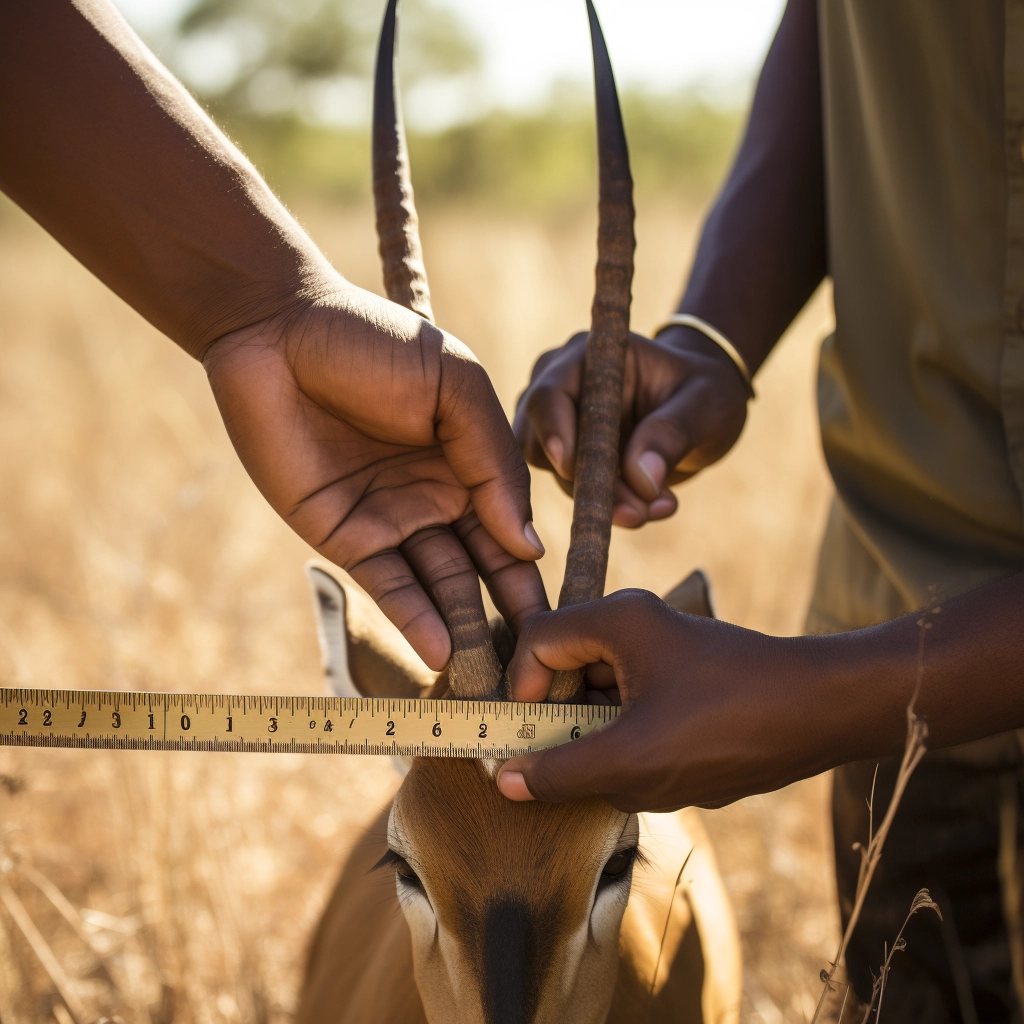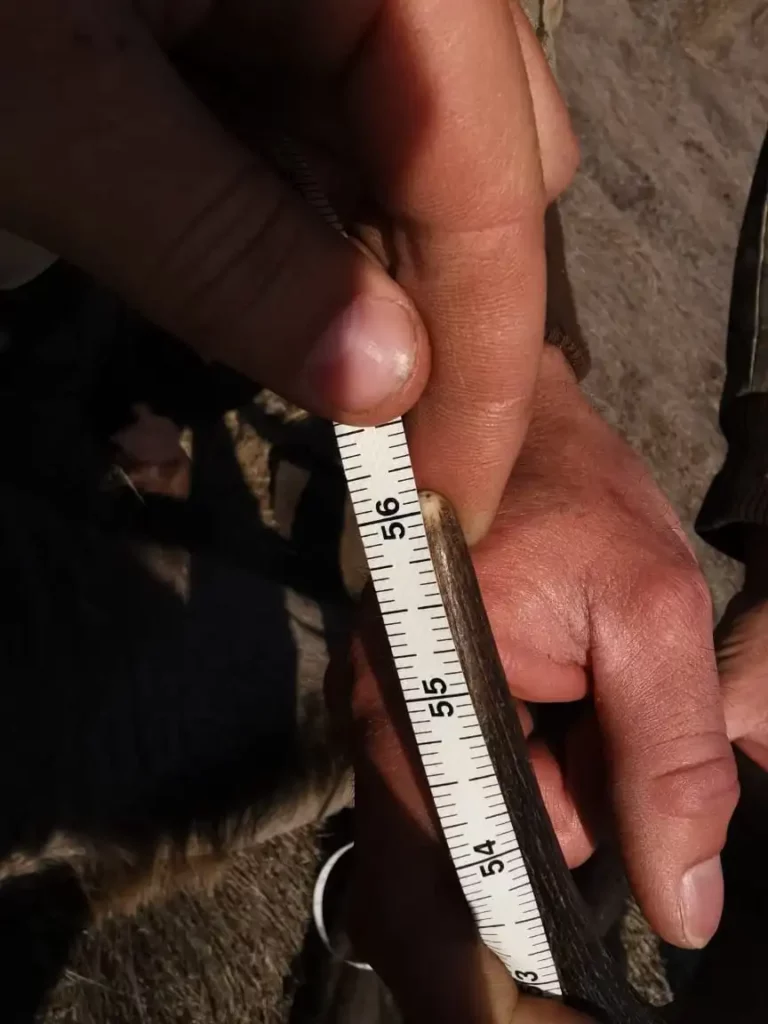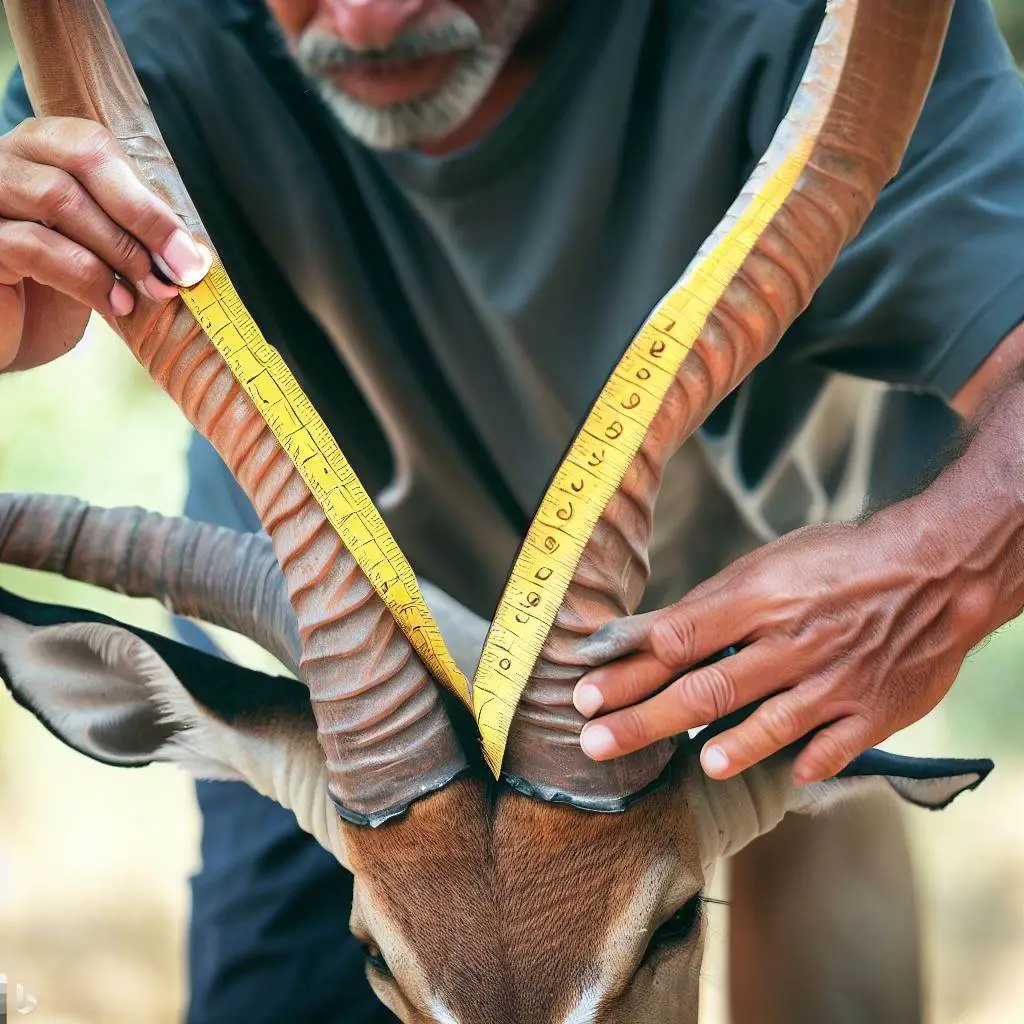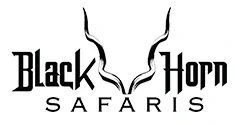In the thrilling world of African big game hunting, two renowned organizations, Rowland Ward and Safari Club International, have established their own sets of minimums and records for African game animals. These benchmarks serve as a testament to the extraordinary hunting achievements of some, while promoting conservation and ethical hunting practices. In this article, we’ll delve into these measuring systems of Rowland Ward minimums and Records and Safari Club Minimums for the Game Animals of Africa, exploring their significance, differences, and impact on the hunting community.


| AFRICAN GAME ANIMALS | R W Minimum | SCI Minimum | RW Record |
| Inches | Inches | Inches | |
| ANTELOPES | |||
| Damaliscs and Hirola | RW Min inch | SCI Min Inch | Record inch |
| Blesbok | 16 4/8 | 40.0 | 20 5/8 |
| Bontebok | 14 | 36.0 | 16 6/8 |
| Hirola or Hunter’s Hartebeest | 23 | ED | 28 4/8 |
| Korrigum | 22 | 58.0 | 33 1/8 |
| Tiang | 20 | 52.0 | 26 4/8 |
| Topi | 16 | 45.0 | 24 3/8 |
| Tsessebe (Sassaby) | 15 | 40.0 | 18 7/8 |
| Duikers | RW Min inch | SCI Min Inch | Record inch |
| Bush Duikers | |||
| Angolan Bush Duiker | 3 | 11.0 | 6 8/16 |
| East African Bush Duiker | 3 12/16 | 11.0 | 6 2/16 |
| Southern Bush Duiker | 4 8/16 | 11.0 | 7 2/16 |
| Western Bush Duiker | 3 8/16 | 10.0 | 6 4/16 |
| Forest Duikers | RW Min inch | SCI Min Inch | Record inch |
| Abbott’s Duiker | 3 | ED | 4 6/16 |
| Aders’s or Zanzibar Duiker | 1 | ED | 1 8/16 |
| Bay Duiker | 2 8/16 | 5.0 | 4 14/16 |
| Black Duiker | 2 8/16 | ED | 6 14/16 |
| Black-fronted Duiker | 3 | ED | 4 12/16 |
| Blue Duiker | 1 12/16 | 4.0 | 2 8/16 |
| Gabon or White-bellied Duiker | 2 8/16 | ED | 5 |
| Harvey’s Duiker | 2 8/16 | 6.0 | 5 |
| Jentink’s Duiker | 4 8/16 | ED | 8 6/16 |
| Maxwell’s Duiker | 1 8/16 | ED | 2 10/16 |
| Natal or Red Duiker | 2 8/16 | 8.0 | 4 2/16 |
| Ogilby’s Duiker | 2 8/16 | ED | 4 12/16 |
| Peters’s Duiker | 3 | 6.0 | 5 14/16 |
| Red-flanked Duiker | 2 8/16 | 7.0 | 4 2/16 |
| Yellow-backed Duiker | 4 8/16 | 13.0 | 8 6/16 |
| Zebra or Banded Duiker | 1 | ED | 3 1/16 |
| Dwarf Antelopes | RW Min inch | SCI Min Inch | Record inch |
| Beira Antelope | 3 | 5 8/16 | |
| Dik-Diks (long snouted) | RW Min inch | SCI Min Inch | Record inch |
| Damara Dik-Dik | 2 8/16 | 7.0 | 4 4/16 |
| Guenther’s Dik-Dik | 2 8/16 | 8.0 | 4 4/16 |
| Kirk’s Dik-Dik | 3 | 8.0 | 4 10/16 |
| Dik-Diks (short snouted) | RW Min inch | SCI Min Inch | Record inch |
| Harar Dik-Dik | 2 | 6.0 | 3 8/16 |
| Phillips’s Dik-Dik | 2 | ED | 2 12/16 |
| Salt’s Dik-Dik | 2 4/16 | 6.0 | 4 10/16 |
| Silver or Piacentini’s Dik-Dik | 2 | 2 | |
| Swayne’s Dik-Dik | 2 | ED | 2 14/16 |
| Grysboks & Steenbok | RW Min inch | SCI Min Inch | Record inch |
| Cape Grysbok | 3 | 7.0 | 5 4/16 |
| African Game Animals | Minimum | Minimum | Record |
| Inches | Inches | Inches | |
| Sharpe’s Grysbok | 1 8/16 | 5.0 | 4 2/16 |
| Steenbok | 4 8/16 | 11.0 | 7 10/16 |
| Klipspringer | 4 2/16 | 11.0 | 6 6/16 |
| Oribis | RW Min inch | SCI Min Inch | Record inch |
| Common Oribi | 5 | 13.0 | 7 8/16 |
| Haggard’s Oribi | 3 12/16 | ED | 6 6/16 |
| Sunis & Relatives | RW Min inch | SCI Min Inch | Record inch |
| Bates’s Pygmy Antelope | 1 | 3.5 | 1 15/16 |
| East African Suni | 2 2/16 | 6.0 | 4 |
| Livingstone’s Suni | 3 4/16 | 9.0 | 5 4/16 |
| Royal Antelope | 1 | ED | 1 6/16 |
| Gazelles | RW Min inch | SCI Min Inch | Record inch |
| Cuvier’s or Atlas Gazelle | 10 | 25.5 | 15 |
| Dama, Mhorr, or Addra Gazelle | 13 | 33.0 | 17 |
| Dibatag or Clarke’s Gazelle | 8 | 20.5 | 13 |
| Dorcas Gazelles | RW Min inch | SCI Min Inch | Record inch |
| Dorcas Gazelle | 11 | ED | 15 |
| Isabelline Gazelle | 9 4/8 | ED | 15 5/8 |
| Pelzeln’s Gazelle | 11 | ED | 14 2/8 |
| Gerenuks or Waller’s Gazelles | RW Min inch | SCI Min Inch | Record inch |
| Northern Gerenuk or Waller’s Gazelle | 13 | 34.0 | 17 |
| Southern Gerenuk or Waller’s Gazelle | 13 | 34.0 | 17 5/8 |
| Grant’s Gazelle & Relatives | RW Min inch | SCI Min Inch | Record inch |
| Bright’s Gazelle | 20 | 51.0 | 26 6/8 |
| Northern Grant’s Gazelle | 23 | 56.0 | 28 7/8 |
| Peters’s Gazelle | 21 | 51.0 | 27 3/8 |
| Roberts’s Gazelle | 23 4/8 | 56.0 | 29 6/8 |
| Southern Grant’s Gazelle | 23 | 56.0 | 31 4/8 |
| Red Gazelle | No set minimum | 13 2/8 | |
| Red-Fronted & Heuglin’s Gazelles | RW Min inch | SCI Min Inch | Record inch |
| Heuglin’s Gazelle | 9 4/8 | ED | 11 7/8 |
| Red-fronted Gazelle | 10 | ED | 13 7/8 |
| Rhim or Loder’s Gazelle | 13 | ED | 16 2/8 |
| Soemmerring’s Gazelles | RW Min inch | SCI Min Inch | Record inch |
| Borani Soemmerring’s Gazelle | 13 | 38.0 | 17 4/8 |
| Somali Soemmerring’s Gazelle or Aoul | 16 | 38.0 | 23 |
| Sudan Soemmerring’s Gazelle | 15 | ED | 20 4/8 |
| Speke’s Gazelle | 10 | ED | 12 4/8 |
| Springbok | 14 | 30.0 | 20 4/8 |
| Thomson’s and Mongalla Gazelles | RW Min inch | SCI Min Inch | Record inch |
| Mongalla Gazelle | 10 4/8 | 28.0 | 14 |
| Thomson’s Gazelle | 13 | 34.0 | 17 2/8 |
| Hartebeests | RW Min inch | SCI Min Inch | Record inch |
| Atlas or Bubal Hartebeest | No set minimum | 15 4/8 | |
| Cape or Red Hartebeest | 23 | 62.0 | 29 4/8 |
| Coke’s Hartebeest | 17 4/8 | 50.0 | 24 |
| Lelwel Hartebeest | 22 | 60.0 | 27 5/8 |
| Lichtenstein’s Hartebeest | 18 4/8 | 53.0 | 24 3/8 |
| Swayne’s Hartebeest | 15 | ED | 20 6/8 |
| Tora Hartebeest | 19 | ED | 22 7/8 |
| Western Hartebeest | 22 | 60.0 | 27 4/8 |
| Impalas | RW Min inch | SCI Min Inch | Record Inch |
| Angolan or Black-Faced Impala | 21 | ED | 26 6/8 |
| East African Impala | 26 | 60.0 | 36 1/8 |
| Southern Impala | 23 6/8 | 54.0 | 31 3/8 |
| Kobs | RW Min inch | SCI Min Inch | Record inch |
| Puku | 17 | 46.0 | 22 1/8 |
| Ugandan Kob | 20 | 48.0 | 27 2/8 |
| Western Kob | 20 | 48.0 | 25 5/8 |
| White-Eared Kob | 20 | 48.0 | 26 |
| Lechwes | RW Min inch | SCI Min Inch | Record inch |
| Black Lechwe | 22 | 54.0 | 31 4/8 |
| Kafue Lechwe | 30 | 70.0 | 37 |
| Nile or Mrs. Gray’s Lechwe | 28 | 64.0 | 34 2/8 |
| Red Lechwe | 26 | 58.0 | 35 |
| Oryxes, Gemsboks, and Addax | RW Min inch | SCI Min Inch | Record inch |
| Addax | 32 | ED | 43 |
| Gemsboks | RW Min inch | SCI Min Inch | Record inch |
| Angolan Gemsbok | 35 | 78.0 | 43 5/8 |
| Common Gemsbok | 40 | 88.0 | 49 4/8 |
| Oryxes | RW Min inch | SCI Min Inch | Record inch |
| Beisa Oryx | 31 | 70.0 | 43 |
| Fringe-Eared Oryx | 30 | 68.0 | 43 3/8 |
| Scimitar-Horned Oryx | 38 | ED | 50 1/8 |
| Reedbucks | RW Min inch | SCI Min Inch | Record inch |
| Bohor Reedbucks | |||
| Abyssinian Bohor Reedbuck | 8 | 13.0 | 12 6/8 |
| Eastern Bohor Reedbuck | 9 | 14.0 | 14 6/8 |
| Nagor Bohor Reedbuck | 7 | ED | 11 7/8 |
| Nigerian Bohor Reedbuck | 8 | 16.0 | 13 |
| Sudan Bohor Reedbuck | 12 | 19.0 | 16 6/8 |
| Common Reedbuck | RW Min inch | SCI Min Inch | Record inch |
| Common Reedbuck | 13 | 21.0 | 19 4/8 |
| Mountain Reedbucks | RW Min inch | SCI Min Inch | Record inch |
| Chanler’s Mountain Reedbuck | 5 | 8.0 | 9 5/8 |
| Southern Mountain Reedbuck | 6 | 11.0 | 10 |
| Western Mountain Reedbuck | 3 | ED | 3 2/8 |
| Rhebok | RW Min inch | SCI Min Inch | Record inch |
| Vaal or Gray Rhebok | 7 14/16 | 18.0 | 11 14/16 |
| Roans, Sables, and Bloubok | RW Min inch | SCI Min Inch | Record inch |
| Roans & Bloubok | |||
| Angolan Roan Antelope | 26 4/8 | 66.0 | 34 |
| East African Roan Antelope | 26 4/8 | 66.0 | 31 6/8 |
| Southern Roan Antelope | 26 4/8 | 66.0 | 39 |
| Sudan Roan Antelope | 27 | 66.0 | 37 2/8 |
| Western Roan Antelope | 27 | 66.0 | 36 2/8 |
| Bloubok | No set minimum | 24 4/8 | |
| Sables | RW Min inch | SCI Min Inch | Record inch |
| Common Sable | 42 | 100.0 | 55 3/8 |
| East African or Roosevelt’s Sable | 34 | ED | 44 6/8 |
| Royal or Giant Sable | 53 | ED | 64 7/8 |
| Spiral-horned Antelope | RW Min inch | SCI Min Inch | Record inch |
| Bongos | |||
| Eastern Bongo | 27 | 70.0 | 39 4/8 |
| Western Bongo | 27 | 70.0 | 37 5/8 |
| Bushbucks | RW Min inch | SCI Min Inch | |
| Abyssinian Bushbuck | 10 4/8 | 25.0 | 14 5/8 |
| Chobe Bushbuck | 14 | 33.0 | 21 6/8 |
| East African Bushbuck | 14 | 35.0 | 24 |
| Harnessed Bushbuck | 11 | 25.0 | 19 6/8 |
| Menelik’s Bushbuck | 11 4/8 | 29.0 | 15 5/8 |
| Nile Bushbuck | 12 | 29.0 | 21 3/8 |
| Shoan Bushbuck | 10 | ED | 10 6/8 |
| Somalian Bushbuck | 11 | ED | 19 4/8 |
| South African Bushbuck | 15 | 33.0 | 21 7/8 |
| Common Elands | RW Min inch | SCI Min Inch | Record inch |
| Cape Eland | 35 | 77.0 | 47 4/8 |
| Livingstone’s Eland | 35 | 79.0 | 44 2/8 |
| Patterson’s or East African Eland | 33 | 74.0 | 42 1/8 |
| Giant Elands | RW Min inch | SCI Min Inch | Record inch |
| Lord Derby or Central Giant Eland | 44 | 98.0 | 56 6/8 |
| Western Giant Eland | 37 | 98.0 | 45 4/8 |
| Greater Kudus | RW Min inch | SCI Min Inch | Record inch |
| Abyssinian Greater Kudu | 42 | 98.0 | 59 4/8 |
| East African Greater Kudu | 50 | 109.0 | 63 4/8 |
| Southern Greater Kudu | 54 | 121.0 | 73 7/8 |
| Western Greater Kudu | 42 | ED | 53 3/8 |
| Lesser Kudu | RW Min inch | SCI Min Inch | Record inch |
| Lesser Kudu | 27 | 62.0 | 36 |
| Mountain Nyala | RW Min inch | SCI Min Inch | Record inch |
| Mountain Nyala | 30 | 75.0 | 46 6/8 |
| Sitatungas | RW Min inch | SCI Min Inch | Record inch |
| Forest or Western Sitatunga | 24 | 45.0 | 37 2/8 |
| Island Sitatunga | 22 | ED | 31 1/8 |
| Nile or East African Sitatunga | 25 | 50.0 | 35 |
| Zambezi Sitatunga | 26 | 60.0 | 36 3/8 |
| Southern Nyala | RW Min inch | SCI Min Inch | Record inch |
| Southern Nyala | 27 | 63.0 | 34 4/8 |
| Waterbucks | RW Min inch | SCI Min Inch | Record inch |
| Common Waterbuck | 28 | 70.0 | 39 3/8 |
| Defassa Waterbucks | RW Min inch | SCI Min Inch | Record inch |
| Angolan Defassa Waterbuck | 24 | ED | 36 1/8 |
| East African Defassa Waterbuck | 27 | 68.0 | 35 |
| Rhodesian or Crawshay’s Defassa | 24 | 55.0 | 31 2/8 |
| Sing-Sing Waterbuck | 27 | 68.0 | 36 2/8 |
| Ugandan Defassa Waterbuck | 28 | 68.0 | 39 2/8 |
| Wildebeests & Gnus | RW Min inch | SCI Min Inch | Record inch |
| Brindled Gnu or Blue Wildebeest | 28 4/8 | 70.0 | 36 |
| Brindled Gnu or Blue Wildebst (non-typical) | 31 | ED | 35 4/8 |
| Cookson’s Wildebeest | 26 | 70.0 | 32 5/8 |
| Nyasaland Wildebeest | 27 | 64.0 | 33 1/8 |
| White-Bearded Wildebeest | 27 | 68.0 | 32 |
| White-Tailed Gnu or Black Wildebeest | 23 | 72.0 | 30 7/8 |
| BUFFALOES | RW Min inch | SCI Min Inch | Record inch |
| Cape Buffalo | 64 | 100.0 | 91 5/8 |
| Central African Buffalo | 48 | 65.0 | 66 1/8 |
| Dwarf Forest Buffalo | 40 | 40.0 | 75 4/8 |
| Nile Buffalo | 50 | 80.0 | 67 4/8 |
| West African Buffalo | 48 | 55.0 | 78 |
| CATS | RW Min inch | SCI Min Inch | Record inch |
| African Cheetah | 12 | 12.0 | 14 8/16 |
| African Golden Cat | 6 4/8 | ED | None |
| African Leopard | 15 4/16 | 14.0 | 19 |
| African Lion | 24 | 23.0 | 28 12/16 |
| African Wild Cat | 6 | ED | 8 4/16 |
| Caracal | 7 | 6.0 | 11 12/16 |
| Serval | 7 | 6.0 | 10 4/16 |
| CIVETS | RW Min inch | SCI Min Inch | Record inch |
| African Civet | 8 | 7.0 | 9 13/16 |
| CROCODILE | Feet | Feet | Feet |
| Nile Crocodile | 13.5 feet | 9 feet | 17 ft. 9 in. |
| DEER & CHEVROTAINS | RW Min inch | SCI Min Inch | Record inch |
| Barbary Red Deer * | No Minimum | ED | 38 1/8 |
| Chevrotains or Mouse Deer | |||
| Water Chevrotain | 7 | ED | 8 3/16 |
| *Record denotes longest antler recorded | |||
| ELEPHANTS | Pounds | Pounds | Pounds |
| Forest Elephant (one tusk) | 40 | ED | 132 |
| Forest Elephant (both tusks) | 70 | ED | 262 |
| Savannah Elephant (one tusk) | 70 | ED | 226 |
| Savannah Elephant (both tusks) | 120 | 100.0 | 440 |
| GOATS & SHEEP | RW Min inch | SCI Min Inch | Record inch |
| Barbary Sheep or Aoudad | 26 | ED | 34 5/8 |
| Ibexes | |||
| Abyssinian or Walia Ibex | 35 | ED | 46 4/8 |
| Nubian Ibex | 35 | 50.0 | 54 4/8 |
| HIPPOS | RW Min inch | SCI Min Inch | Record inch |
| Common Hippopotamus | 24 | 50.0 | 35 5/16 |
| Common Hippopotamus (atypical) | 28 | ED | 64 8/16 |
| Pygmy Hippopotamus | 5 | ED | 12 |
| HYENAS | RW Min inch | SCI Min Inch | Record inch |
| Brown Hyena | 15 | ED | 18 |
| Spotted Hyena | 16 | 15.0 | 19 12/16 |
| Striped Hyena | 13 | ED | None |
| PIGS | RW Min inch | SCI Min Inch | Record inch |
| Barbary Wild Boar | 6 8/16 | ED | 9 14/16 |
| Bush Pig | 6 | 11.0 | 9 |
| Bush Pig (atypical) | 7 8/16 | ED | 11 14/16 |
| Giant Forest Hog | 7 8/16 | 14.0 | 15 8/16 |
| Red River Hog | 5 | 11.0 | 11 |
| Warthog | 13 | 30.0 | 24 |
| RHINOS | RW Min inch | SCI Min Inch | Record inch |
| Black Rhinoceros | 22 | 56.0 | 53 4/8 |
| White or Squared Mouthed Rhinoceros | |||
| Northern Square-Mouthed Rhinoceros | 28 | 70.0 | 50 1/8 |
| Southern Square-Mouthed Rhinoceros | 26 | 70.0 | 62 2/8 |
| Introduced Game of Africa | RW Min inch | SCI Min Inch | Record inch |
| Antelope | |||
| Lechwe Red/Kafue | 26 | 58.0 | 29 4/8 |
| Scimitar-Horned Oryx | 38 | ED | 40 4/8 |
| Deer | |||
| European Fallow Deer | 110 | 150.0 | 168 4/8 |
| Rusa Deer | 125 | ED | 146 1/8 |
| Goats/Sheep | |||
| Barbary Sheep or Aoudad | 27 | ED | 34 4/8 |

Embarking on a safari adventure across the vast landscapes of Africa is a dream for many hunting enthusiasts. Among the many elements that define a successful hunt, achieving trophy-worthy animals stands out. Both Rowland Ward and Safari Club International have established criteria for recognizing such remarkable hunting accomplishments.
Understanding Rowland Ward Minimums and Records
Rowland Ward measurement minimums refer to the standardized measurements that a game animal must meet or exceed to qualify for recognition in the Rowland Ward Records of big game. These measurements encompass various aspects, such as horn length and circumference.
The History and Legacy of Rowland Ward
Founded in 1870 by James Rowland Ward, this organization initially focused on taxidermy and preserving hunting memories. Over time, it developed a comprehensive measurement system for trophy animals, becoming a prestigious record-keeping institution.
How are Rowland Ward Records Determined?
Rowland Ward Records are determined by meticulous measurements taken from the harvested animals. A team of experts evaluates the measurements to ensure accuracy and compliance with the established standards.
Safari Club International: A Brief Overview
Safari Club International (SCI) is a prominent organization that celebrates hunting achievements while promoting wildlife conservation and community involvement. Casper Johnny McElroy founded Safari Club International (SCI) in 1972. He was a lifelong hunter and conservationist who was passionate about protecting the freedom to hunt and promoting wildlife conservation. SCI’s scoring system is based on the Safari Club International Trophy Measurement System.
Safari Club Minimums and Their Purpose
SCI sets minimum scores for different species, encouraging hunters to target animals that have reached a certain level of maturity. This approach aligns with ethical hunting practices, as it allows animals to grow and contribute to the ecosystem before being harvested.
Criteria for Recognizing Trophy Animals
SCI’s scoring system takes various measurements into account, including horn length, spread, and mass. This comprehensive approach provides a holistic view of the animal’s size and age, ensuring that only exceptional specimens are recognized.
Comparing Rowland Ward and Safari Club International
Rowland Ward and SCI utilize different measurement systems, leading to variations in recognized trophy animals. These variations contribute to the diversity of hunting achievements celebrated by both organizations.
Variations in Species Recognition
Due to different measurement criteria, the same species might qualify for recognition by one organization but not the other. This disparity underscores the unique perspectives each organization brings to trophy hunting.
Impact on Conservation
While some critics argue that trophy hunting negatively impacts conservation, both Rowland Ward and SCI emphasize the importance of sustainable hunting. Funds generated through hunting permits and activities often contribute to conservation efforts and local communities.
Controversies Surrounding Trophy Hunting
Trophy hunting has long been a topic of controversy, with concerns about its impact on animal populations and ecosystems. Advocates argue that well-regulated hunting can benefit conservation, while opponents emphasize the need to prioritize animal welfare.
Conservation and Sustainable Hunting
Both Rowland Ward and SCI are committed to sustainable hunting practices. They collaborate with local communities and authorities to ensure that hunting benefits both wildlife conservation and livelihoods.
The Thrill of the Hunt: Stories from the Field
Hunters often recount tales of remarkable hunts that led to record-setting trophies. These stories not only celebrate hunting skills but also highlight the awe-inspiring beauty of Africa’s wildlife.
A Hunters Perspectives on Minimums and Records
Many hunters view achieving Rowland Ward or SCI recognition as a prestigious accomplishment. However, some emphasize the broader significance of the experience, including cultural immersion and personal growth.
Ensuring Accuracy and Fairness
Accurate measurements are essential to maintain the credibility of both Rowland Ward and SCI. Technological innovations help mitigate human error and ensure fairness in recognizing exceptional animals.
Balancing Conservation and Hunting
Ethical hunting involves striking a balance between hunting traditions and conservation imperatives. Organizations like Rowland Ward and SCI play a pivotal role in promoting ethical hunting practices.
Local Communities and Wildlife Management
Hunting permits and fees contribute to local economies, fostering a sense of responsibility among communities to protect their wildlife resources. This economic incentive aligns with conservation goals.
Evolution of Minimums and Records
As conservation and hunting practices evolve, minimums and records may also undergo changes. Adaptations could reflect updated scientific knowledge and shifting societal values.
Shaping the Future of African Hunting
Rowland Ward and SCI continue to shape the future of African hunting by promoting sustainable practices, engaging in conservation initiatives, and fostering a deeper appreciation for Africa’s rich biodiversity.
Conclusion
The pursuit of trophy animals in Africa has brought together organizations like Rowland Ward and Safari Club International to recognize exceptional hunting achievements while championing conservation. These institutions contribute to the complex narrative of ethical hunting, showcasing how responsible hunting can coexist with wildlife preservation and community development.
FAQs (Frequently Asked Questions)
Are Rowland Ward Minimums and Safari Club International Minimums the same?
Rowland Ward and Safari Club International have distinct measurement systems and criteria, resulting in differences in how they record and recognize trophy animals.
How do these organizations contribute to conservation?
Both Rowland Ward and SCI organizations collaborate with local communities and allocate funds from hunting activities to support conservation efforts.
Can technology replace traditional measurement methods?
Technology enhances accuracy, but human expertise remains crucial in ensuring precise and ethical measurements.
Why is trophy hunting considered ethical by some?
Advocates argue that regulated trophy hunting can generate funds for conservation and incentivize communities to protect wildlife.
What does the future hold for African hunting?
The future will likely see a continued emphasis on sustainable hunting practices, technological advancements, and stronger community involvement.
References:
- Smith, J. A. (2020). The Legacy of Rowland Ward: A History of Trophy Hunting and Conservation. Journal of Wildlife Management, 45(3), 214-230.
- Brown, L. B., & Johnson, R. M. (2018). Ethical Considerations in African Big Game Hunting. Conservation and Society, 16(2), 182-197.
- Safari Club International. (2023). SCI Trophy Measurement Guidelines. Retrieved from https://www.safariclub.org/what-we-do/sci-record-book/trophy-scoring-guidelines
- Rowland Ward Records. (2023). Measuring Your Trophy. Retrieved from http://www.rowlandward.com/rowland-ward-trophy-measurement.htm

Adrian Anderson first obtained his Professional Hunters license in 1991. He is a Big Five and Dangerous Game licensed Professional Hunter and Hunting Outfitter. He has a tremendous love for wildlife and the African bush and enjoys sharing his knowledge with the hunting clients that he guides. Guiding hunters in Africa’s wild places is a passion and seeing them succeed with their goals brings satisfaction. With knowledge of the Safari industry built up over 32 years he is well qualified to give guidance to his hunting clients.
